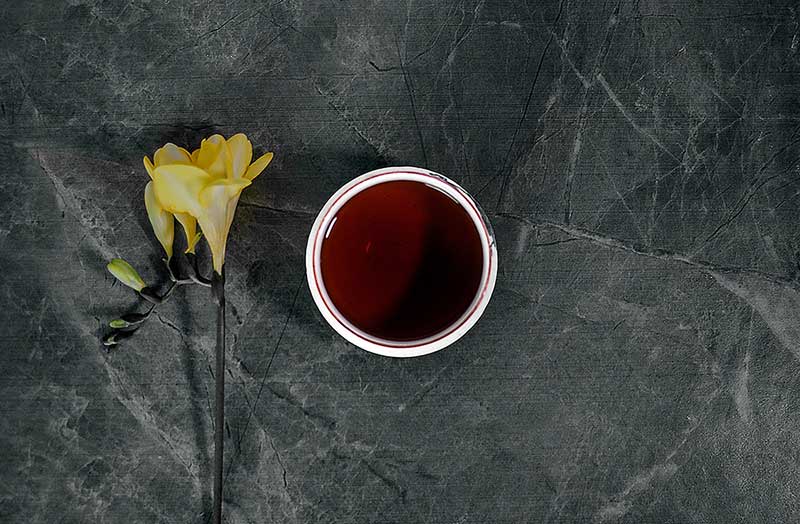Pu’erh is not for everyone. A tea that attracts many drinkers with its unique earthly taste and notes acquired during ages of fermentation has an ugly side too. In fact, some pu’erhs are not good for anyone. Is there a hidden danger in pu’erh tea?
Raw and Ripe Pu’erh
There are two types of pu’erh tea – raw and ripe. Raw pu’erh is made from leaves that were aged for years in order to gain mellow and unique flavor. Along with the age come different benefits related to bacteria and tea leaf compounds. Ripe pu’erh is artificially fermented to skip the years of aging while still providing the same benefits.
Unlike raw pu’erh, ripe pu’erh is ready for consumption immediately after production. Flavor will rarely drastically change after aging and might only become a bit mellower. On the other hand, raw pu’erh needs years of fermenting to gain mellow and sweet flavor.
So where is that hidden danger in pu’erh tea?
Along with numerous proven benefits, a hidden danger in pu’erh tea comes from mycotoxins, toxins produced by some mold. This is more likely happen with raw pu’erh stored and aged for years in inappropriate conditions, rather than ripe pu’erh created with forced fermentation. However, ripe pu’erh is often aged too, and processed and stored in conditions that attract mold. The most suspectible tea, both ripe and raw, is the one aged in wet storages[1].
Not only storage conditions create a good opportunity for mold to attach to tea. In fact, “tea fungal contamination can occur at any stage of tea production,[2]“ and the longer the process, the higher the chances of contamination. Tea fields can be contaminated as well, with toxins being transferred through every step of production. With pu’erh, the risk is even higher, because the “post-fermentation stage welcomes fungal contamination[3]”.
The most common mycotoxins in pu’erh tea are aflatoxin, ochratoxin A and vomitoxin. Aflatoxin is a poisonous mold, that is usually found in damp and unclean environment. It can cause“serious and sometimes fatal diseases[4]” and is usually either inhaled or ingested. With tea, aflatoxins can be released into water when brewing. Although cancerogenic aflatoxin is often regarded as the worst of all poisonous molds, others are dangerous as well. Ochratoxin A may be responsible for causing kidney failure,[5] and vomitoxin or deoxynivalenol, for severe vomiting and nausea. Vomitoxin might be a very common intruder in pu’erh tea. One research that included pu’erh tea from a tea market in Guangzhou showed 63 out of 70 samples had amounts of this mycotoxin that exceeded safety levels[6].
Pu’erh is probably one of the least controlled tea, especially considering that many tea drinkers buy tea online, not knowing what the pu’erh tea label says or where the tea brick comes from. High prices of famous pu’erh made low cost versions quite attractive, but quite risky for health as well.
 (Source: Tea Bespoke)
(Source: Tea Bespoke)
Is it worth drinking?
Pu’erh could offer more benefits for certain health conditions than other tea types, but it’s not worth taking risk by drinking tea from suspicious sources. FDA allows extremely low levels of aflatoxins in food imported from other countries. Tea should always come from factories caring about hygiene and safety rather than mass-producing tea of dubious quality. Loose leaf tea is often less risky than tea in tea bags. Flavor can also be a warning sign. Although it’s difficult to say whether the flavor is influenced by mold or other factors, all tea with moldy, acidic, metal or other unpleasant notes is best avoided.
Want to learn more about pu’erh? Read our article on the shapes of pu’erh tea.
[1] http://www.lifescienceglobal.com/pms/index.php/jbas/article/view/2217
[2] https://www.mdpi.com/2072-6651/10/11/444/htm
[3] https://www.mdpi.com/2072-6651/10/11/444/htm
[4] https://www.who.int/bulletin/archives/77(9)754.pdf
[5] https://www.hindawi.com/journals/jeph/2012/835059/
[6] http://www.lifescienceglobal.com/pms/index.php/jbas/article/viewFile/2217/1318



I bought Pu'erh tea from Beijing 6 yrs ago. At the time the compacted tea was moist but after all these years stored in cupboard, the tea dried up. Was wondering if it is safe to drink. I tried it but the taste has not altered. Wait for your reply. Thank you.